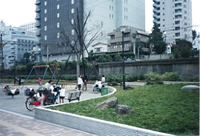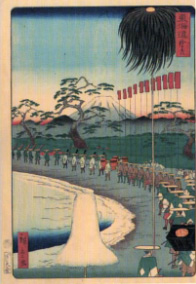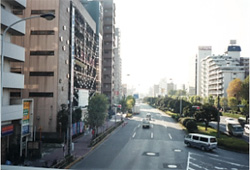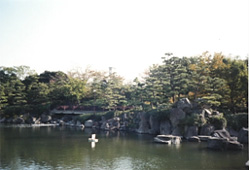|
|
1.History and culture of coasts
(1) Introduction
As coasts have long been a part of the lives of Japanese people, the history and culture of coasts can be traced back in coastal areas throughout the nation. Different coasts have differing climates, regional characteristics, trends, social conditions, economic contexts, and geographical aspects.
Thus, it is essential to understand the history, climate, literature, and culture for dealing with coasts with unique characteristics.
2. Examples of the history and culture regarding coasts
|
(1) Ruins
Contact between the sea and humans can be known from shell mounds. The Omori Shell Mounds (Ota Ward and Shinagawa Ward, Tokyo) were formed in the late Jomon period (4,000 to 5,000 years ago). In addition to seashells, pottery, clay figures, stone axes, human bone fragments, and deer and whale bones have been excavated from the shell mounds, providing a glimpse of how people used to survive by hunting and fishing. The Omori Shell Mounds were discovered by Dr. Morse, an American zoologist, in 1877 while aboard a train on the Tokaido Line. Presently, the monument of the shell mounds excavation stands along the railroad on the northwestern side of Omori Station on the Keihin-Tohoku Line, revealing the location of the coastline in the late Jomon period.
|

Children playing where the seashore used to lie in ancient times
(near Omori Station on the Keihin-Tohoku Line: The Omori Shell Mounds were discovered on the other side of the elevated railroad track.)
|
(2) Prints
The present-day environs of the Omori Shell Mounds can be compared with the scenery in the Edo era.
The figure on the right shows Utagawa Hiroshige's print of the daimyo's procession (a regional feudal lord traveling with a large entourage to comply with the compulsory system of alternate-year residence in Edo established by Tokugawa Shoguns) going through Suzugamori of the Tokaido highway. At that time, there was a sand beach along Tokyo Bay, and the Tokaido highway ran along the bay and was sufficiently wide for the procession to travel. This place is near Omori-kaigan Station on the Keihin-kyuko Line in Minami-Oi, Shinagawa Ward, Tokyo, through which Route 15 now passes. The Tokaido highway in the Edo era was located about 500 m coastward from the Omori Shell Mounds, showing that the coastline has recessed from that in the Jomon period.
This place was outside of the town in the Edo era, but now buildings are crammed side by side and on the coastward side lie Shinagawa Kumin Park and Oi Horse Race Track.
|

"Suzugamori, Tokaido" one of the prints of Utagawa Hiroshige II
(collection of the Shinagawa History Museum operated by Shinagawa Ward, Tokyo)
|
 |
 |
Street which used to be part of the Tokaido Highway
(near Omori-kaigan Station on the Keihin-kyuko Line) |
Shinagawa Kumin Park
(The lights of the Oi Horse Race Track can be seen beyond the park.) |
(3) Literature
The state of the sea can be traced in the written literature. There are numerous islets in Kisakata Bay, Akita Prefecture, which were formed by rock avalanches sliding into the Sea of Japan 2,600 years ago when Mr. Chokai erupted.
The magnificent scenery of many islets in the bay competes with that in Matsushima in Miyagi Prefecture, and many literary persons visited Kisakata. Matsuo Basho, that famous Haiku poet, visited Kisakata in 1689 (the second year of the Genroku period), and composed a Haiku that likened the scenic beauty of Kisakata Bay in rain to Xishi (Seishi), one of the three most beautiful women in China, as follows.
Kisakata no ame ni Seishi ga nebu-no-hana
(Kisakata bay in rain, as if Xishi asleep like Albizia (nebu) blossoms)
Then, the 1804 Kisakata earthquake (lower plate) raised the lagoon and connected it to the land. Ishii Rogetsu, another Haiku poet, composed a haiku of this scenery in 1906 (the 39th year of the Meiji era) as follows.
Kisakata wa umorete semi no koe atsushi
(Buried is Kisakata Bay, and alive is the chirring of cicadas in chorus)
The changes in the coastal topography can be traced from such literary works.

|